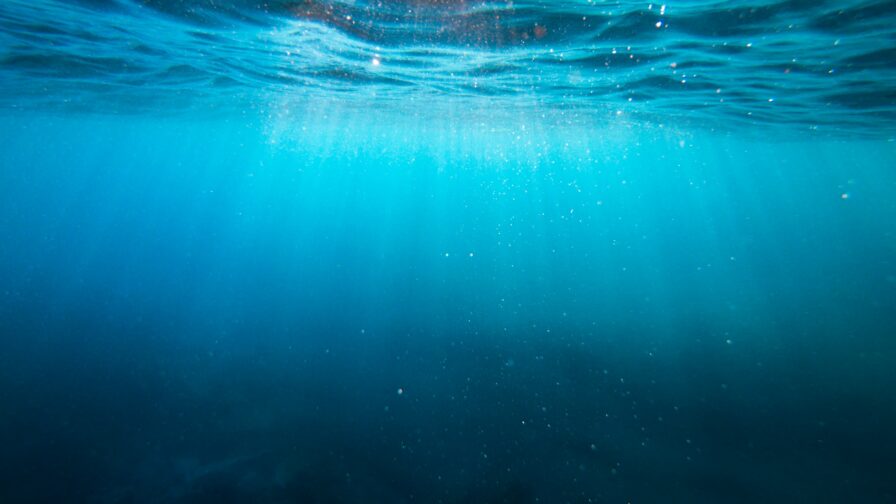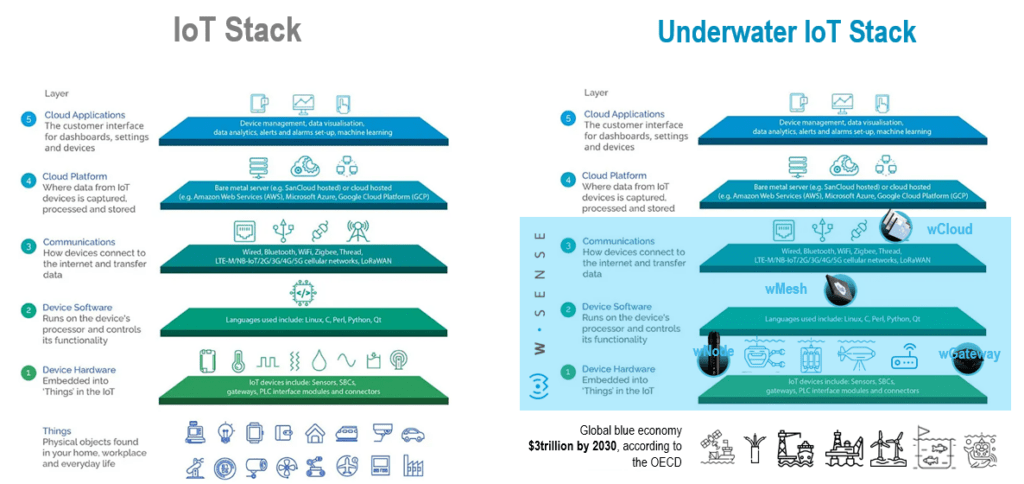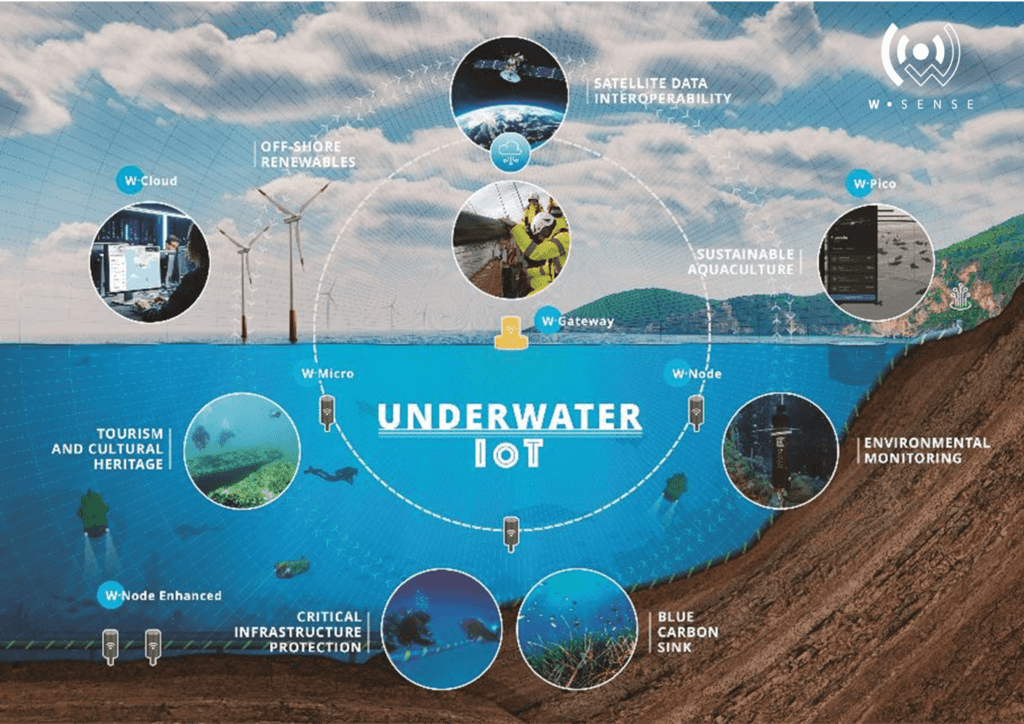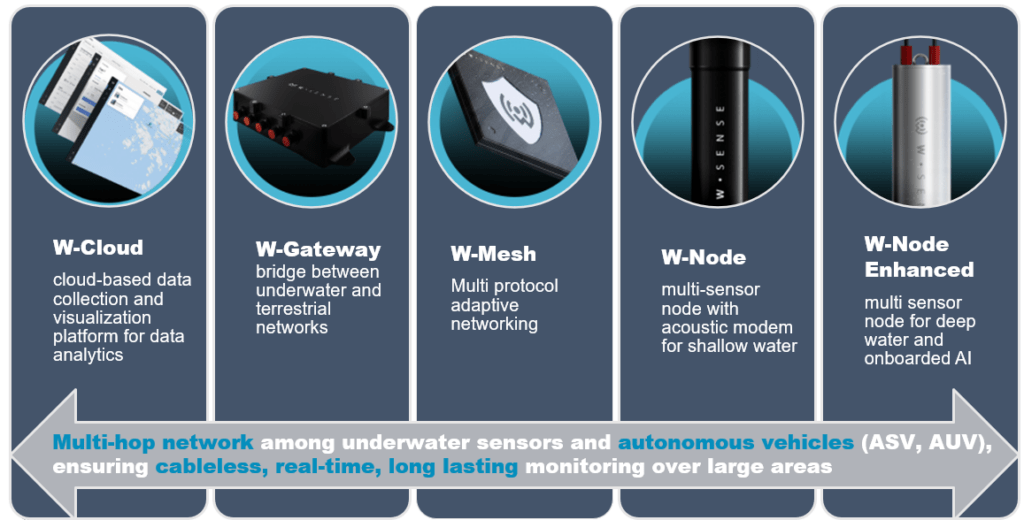
Underwater IoT (IoUT) in a Nutshell
Underwater Internet of Things (IoUT) is a groundbreaking development in technology that has transformed how we understand and interact with the world’s oceans and seas. It is an innovative field of study pioneered by Italian company WSense that integrates Artificial Intelligence and Machine Learning to streamline data acquisition and complex operations for a variety of applications.
Differences between terrestrial and underwater IoT
While both Underwater IoT (IoUT) and Terrestrial IoT share a common goal of data collection and analysis, the nature of the environments they operate in necessitates profoundly different approaches. Terrestrial IoT primarily uses radio frequencies for communication. It thrives in a world of Wi-Fi, 4G, and 5G networks, which are abundant and reliable on land.
However, these radio frequencies are not suitable for underwater environments due to their limited range in water. IoUT, on the other hand, leverages acoustic waves for communication. Acoustic waves can travel far and wide underwater, albeit at a lower speed and with more latency compared to radio waves. This fundamental difference in communication mediums leads to unique challenges and innovations in the design and operation of Underwater IoT systems. IoT Insider article

Impact in Sustainability
Thanks to marine sensors, cameras, hydrophones, data storage microchips, and actuators it is now possible to gain deeper insights into what’s going on below the ocean’s surface. These devices collect and transmit data to onshore stations or cloud-based solutions, where it is subsequently analyzed for patterns and trends.
Of course, this opens many new and exciting options for sea (and global) sustainability. For instance, these sensors and cameras can enable the real-time monitoring of marine ecosystems, helping scientists to detect abrupt changes in underwater conditions promptly. This facilitates swift intervention, potentially preventing irreversible damage.
IoUT can also significantly aid in the tracking and control of water pollution, oil spills, container movements, shipwrecks, fishing activities, CO2 emissions, temperature shifts, and more.
Expanding Horizon of Applications
But underwater IoT is not limited to environmental monitoring, and its potential expands to several other sectors of the blue economy and beyond.
The implementation of IoUT in oil and gas operations can help detect leaks or malfunctions in real-time, preventing catastrophic environmental disasters. For instance, sensors deployed in the ocean can monitor seismic activity, enabling early detection of potential tsunamis. This can lead to timely evacuation and disaster management, ultimately saving lives and reducing damage.
With underwater sensors and cameras, authorities can also detect unauthorized vessels or underwater activities, enhancing maritime security.
Moreover, marine archaeologists can leverage IoUT for deep-sea exploration, discovering hidden historical treasures, and unraveling the mysteries of the past. This could even open up new avenues for anthropological research, contributing to our understanding of human history!

IoUT: Technical Challenges and Solutions
Unlike traditional IoT, IoUT faces unique challenges due to the physical properties of underwater environments, which, as we know, significantly affect wireless communication.
Unique Challenges of Underwater Environments
The team at WSense has made considerable strides in establishing reliable underwater wireless networks. They have developed an in-house suite of applications and hardware, including nodes, modems, and gateways, to effectively manage communication and device integration within the IoUT architecture. Moreover, WSense has integrated dozens of third parties probes and sensors that normally are deployed underwater leveraging cables to transmit data from underwater to the surface.
Designing Optimal Communication Networks for IoUT
The design of an optimal communication network for IoUT is a challenging yet exciting field that is continually pushing the boundaries of what’s possible in underwater exploration and monitoring.
Designing optimal communication networks for underwater IoT calls for advanced technical knowledge and innovative thinking. One of the primary considerations is the selection of an appropriate communication medium that performs well in the different underwater scenarios.
For instance, the network design for monitoring marine life would differ significantly from a network deployed for oil and gas rig exploration. The former might require low energy consumption and minimal disturbance to marine life, while the latter would necessitate real-time data transmission and a high level of reliability.
Underwater communications: multi-hop mesh networks
Using cables in underwater IoT, more than creating sustainability issues and cost of ownership constraints, drastically reduces the capability to measure and control large areas of the ocean at different depths. What WSense has created is a multi-hop mesh network that leveraging wireless communication can create different network topologies to cover large areas without using cables. A wireless mesh network is a multi-hop wireless network formed by a number of stationary wireless mesh routers (Wgateway and WNodes).. These routers are connected wirelessly using a mesh-like backbone structure. This is the same paradigm used over the water for standard communications and has drastically transformed the way to deploy underwater systems. WSense has developed hardware and software to manage reliable communication and make the network data and protocol management adaptive to water and operational conditions.
Data Acquisition and Sensor Networks in IoUT
The process of data acquisition and sensor networking in the Underwater Internet of Things (IoUT) is a sophisticated one that involves several components working in harmony. This includes underwater sensing devices, acoustic modems for communication, and a number of intelligent algorithms that enable reliable data transfer. Let’s take a look at the whole process.
Marine Sensors as the Foundation of Data Acquisition
The journey of data in the IoUT begins with marine sensors. These devices are strategically placed in various parts of the ocean to collect specific types of data, such as temperature, salinity, pressure, acoustic signals and images. They are designed to withstand the demanding conditions of the marine environment and can operate for extended periods without human intervention.
Components of the Sensor Network
The sensor network comprises the interconnected marine sensors and the nodes that form the backbone of the IoUT. Nodes are devices equipped with processors and memory that can receive and transmit data. These nodes can be stationary (anchored to the seabed) or mobile (attached to autonomous underwater vehicles), depending on the application. Every node is capable of executing complex computations and communicating with other nodes, creating an intricate web of connections beneath the sea.
Integration of data
After acquiring data, the nodes process it and transmit it through the underwater network. This process involves a combination of technologies such as acoustic, optic, and cloud architecture to ensure data interoperability.
The role of AI and ML
The convergence of Machine Learning (ML) and Artificial Intelligence (AI) with the Underwater Internet of Things (IoUT) has opened up a realm of possibilities for extracting meaningful insights from the vast amounts of data generated by underwater sensors and devices.
Performing Complex Data Operations
ML and AI algorithms are uniquely suited to address the challenges of underwater data processing, enabling a deeper understanding of oceanographic phenomena, resource exploration, and marine conservation.
In the underwater environment, data acquisition and communication are inherently complex due to the attenuation and scattering of electromagnetic waves. ML algorithms can adapt to these challenges by employing acoustic communication methods and developing robust signal-processing techniques. This allows for the collection of continuous data streams from underwater sensors, providing a rich source of information for analysis.
Leveraging Algorithms for Data Archiving and Analytics
ML algorithms excel at performing complex data operations in the underwater domain. Anomaly detection, a key task in underwater monitoring, can be effectively implemented using ML techniques to identify deviations from normal patterns in sensor data. This can help in detecting potential equipment malfunctions, environmental anomalies, or intrusions into the underwater infrastructure.
Predictive maintenance, another crucial application of ML in IoUT, can extend the lifespan of underwater assets by forecasting potential failures based on sensor data and historical patterns. ML algorithms can analyze sensor readings and identify signs of wear and tear, enabling proactive maintenance actions to minimize downtime and reduce operational costs.
Big Data Integration
The more underwater data is springing from water the more, as happened in traditional IoT, the convergence of data integration layers is needed. There is an ongoing research and effort to integrate those data with operational data and with other relevant sources like satellite data. The combination of in situ data underwater plus the satellite data coming from the surface of the ocean can create an unbeatable process to create actionable and reliable decision processes. This convergence is opening up new R&D and analytical areas to create the best of breed decision making tools and WSense as a group of researchers and practitioners fully dedicated to make the integration as flexible as possible and the visualization and analytics powerful and actionable.
Video and Image Compression Research
Data archiving and analysis in the underwater environment present unique challenges due to limited bandwidth and the need for efficient storage solutions. ML algorithms can also be employed to compress and organize data, making it more manageable and accessible for further analysis. This enables real-time decision-making and long-term data storage for trend analysis and scientific research.
The next step in Underwater IoT research is to use more AI/ML to allow the compression of images, videos and audio streams to be compressed and sent underwater preserving their quality and actionable value for decision makers. This stream of work is approached by Wsense with relevant industrial partners as well as with best of breed research groups from different universities and companies
Making the Blue Economy Real
Preserving the ocean is paramount, as it provides vital resources and ecosystem services that enable many activities that are essential to human well-being. Over 40% of the global population relies on the biodiversity and services provided by marine and coastal ecosystems, which contribute to economic and social development. Annual revenues generated from ocean economy sectors are estimated at $5.2 trillion, while the ocean’s total asset value is estimated at $24 trillion. Protecting and restoring Blue Natural Capital is crucial to securing benefits for current and future generations, leading to sustainable and resilient development. (ref. Link)
To make the most out of IoUT, WSense has developed in-house software and hardware solutions that can adapt to the different challenges of the underwater world. Here are some examples of solutions developed by the company’s IT team:

- The WSense IoUT platform is an all-in-one solution that covers the end-to-end needs from data acquisition to storage and visualization.
- IoUT devices like WNode and WNode Enhanced can be integrated with artificial intelligence, cameras, and hydrophones, making it possible to control the acoustic network.
- WMesh, on the other hand, is a patented multiprotocol networking approach that inherently enhances wireless data reliability, interoperability, and security.
- To bridge the gap between underwater networks and various control centers, WSense has developed WGateway,
- WCloud acts as the final station of all data, where everything comes together for analysis.
Make a Difference!
By working on the Internet of Underwater Things (IoUT), we shed light on one of the Earth’s most vital ecosystems: the oceans. If you’re a developer seeking to deepen your understanding of AI, machine learning, cloud architecture, and big data, you’ll discover a perfect fit within the diverse projects that WSense is breathing life into!





